 |
| Credit: Jose C Juarez |
I really admire many Oak species for various individual characteristic reasons. But one that I've always admired for it's ability to grow in the harshest of conditions of any I have observed from toughness stand point is Engelmann Oak (Qurecus engelmannii). While there are many photos out there showing a luxuriant example in an ideal location in the sense of habitat, soil and water availability which make for majestic Oak photo opportunity, it's the Engelmann examples that impress me far more. Many giant oaks are going to be found growing in Valleys, floodplains where ample water & deep soils are to be found. But I'm talking about the ability of Engelmann Oak growing to large stature on a steep southern exposed slope. In SoCal and inland, these are some of the hottest driest locations. This speaks volumes to me as to this Oak's toughness under harsh extremes and a hot dry southern mountain slope doesn't get any more extreme than that. Now that's in the backcountry of a rural area of the southwest which has some of the nasty conditions imaginable for plants to survive and yet Engelmann Oaks thrive here. This makes an urban landscape environment an ideal paradise by comparison, where such plants should thrive under the loving care of a gardener or Landscaper. Although admittedly many well meaning gardeners and landscapers can mother their native plants to death sometimes. One of the best areas to observe prime examples of tough Engelmann in the wild beating the odds of a typical nasty drought condition habitat is at the Santa Ysabel Open Space Preserve. The sign above is west of Santa Ysabel and east of Witch Creek (area of the infamous 2007 fire). Below are some photos I took when I first arrived at the beginning of April on my way to Ranchita CA.
 |
| Credit Intermountain Fire and Rescue, Hwy 78, Ramona CA |
This location above with the hill behind is a great starting point to view Engelmann Oak in a dry hot scenario is on a southern slope. This is also an area ravaged by another infamous megafire named the 2007 Witch Creek Fire which swept through the area. It is located directly across from the well known Pine Hills Egg Ranch. The following photo is just to the east of this shot.
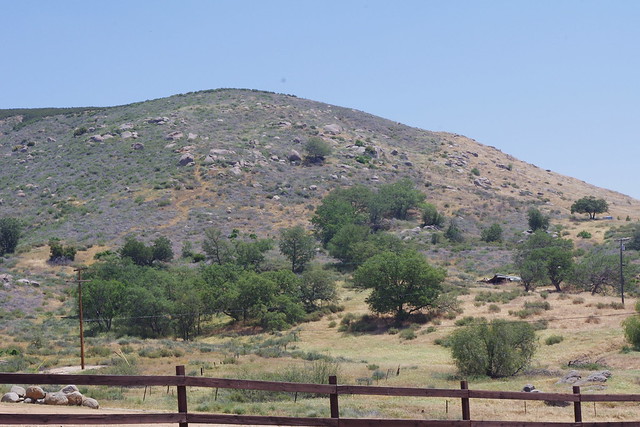 |
| Credit: Mine |
This picture is facing the southern slope in an usually dry hot location in the San Diego backcountry where most plants fail other than low growing inland sage scrub plant community with Sages and Buchwheats. And yet we find large specimens of Engelmann Oak not only making this their home, but actually thriving on such an inhospitable location.
 |
| Credit: Mine |
Santa Ysabel Creek is just beyond the foreground grassland hill with the Engelmann Oak covered mountain as the background. The gray coloured shrubs between the Oak Trees are actually a very low growing White Sage (Salvia apiana) and some small shrubby Silver Sagebrush (Artemisia cana). Interestingly the chaparral here facilitates the grow of this tree's acorns for which the Western Scrub Jay is the landscape designer. Oddly enough the Oaks do better within the interior sage scrub than the annual weedy grasses, much of which is non-native.
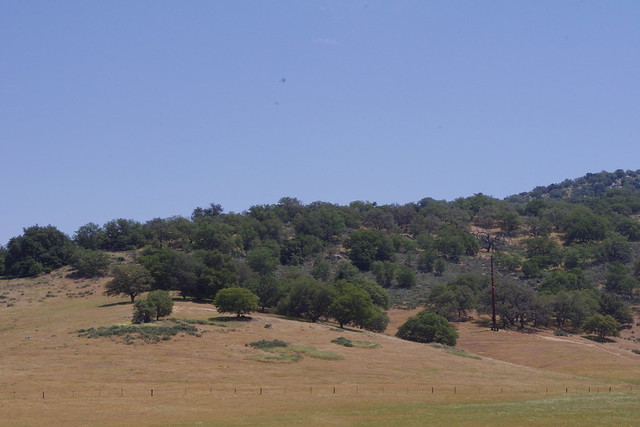 |
| Photo: Mine |
This is looking directly east from the eastern portion of the Santa Ysabel Preserve entrance on Hwy 79 north of Santa Ysabel itself. While in this picture there may be one or two other trees like Interior Live Oak (Quercus wislizeni), but it is mostly the tough Engelmann Oak trees which dominates here.
Okay shifting some gears here for a bit on or in another area of San Diego County and subject of viewing these trees. One of the most remarkable things I like specifically about these Oak Trees when comparing them to other Oaks is their ability to self prune themselves into twisted picturesque shapes and/or forms. The California Sycamore also has an amazing ability to twist and shape itself and much of this is environmental and no doubt the same with the Engelmann Oak. Cal-Sycamores are influenced by what is called Anthracnose Canker which effects newer leaves causing side shoots to become the new leader bud which often may grow in a different direction than the original. Often this may even cause quite a bit of leaf drop, but I've never noticed this to be fatal to the tree. The result really is the picturesque contorted or twisted features for which they are known. In the shaping of the Engelmann Oak, they are drought-stress deciduous which may account for their amazing ability to survive where the other oaks will not. It also may allow them to not only drop leaves, but perhaps also twigs and even small branches giving it, it's often picturesque shapes. For me the best place for viewing these almost tropical picturesque shapes was on the switched back grade on Hwy 76 between the Junction of the Valley Center Road and the Oak Knoll Campground on the La Jolla Indian Reservation. This has always had some of the most beautiful forms of Engelmann Oak I've ever seen. I haven't visited there this time as I've had a lot on my photo shoot plate, but I'm not sure of their condition after that 2007 Poomacha Fire which burned at the same time as other notorious fires back then like 2007 Witch Creek Fire. Still I'm curious as to what these areas look like since the region was almost pure Engelmann Oak woodlands.
Shifting gears again, I have another interesting note about the Engelmann Oak's acorn germination. In the early/middle 1970s, much of the literature I first found on acorn germination mentioned an interesting phenomena noted with one oak, the Gambel (Quercus gambelii) in particular which when it dropped it's acorns, the acorn germinated immediately upon to toughing the ground. With many acorns Scrub Jays often collect and bury acorns and germination under a favourite chaparral commences. With the Gambel it made sense because of the heavy monsoonal rains which are prevalent in it's range in Colorado, Utah, New Mexico and Arizona. But during the 1980s wet monsoonal seasons I also saw the same germination effect with Engelmann Oak as with Gambel Oaks. Below is a photo of just the exact tree where I first saw this phenomena. It is a single Engelmann Oak along Hwy 79 across from the Old Schoolhouse Road turnoff on Santa Ysabel Indian Reservation in San Diego Co. Below is a picture of that very oak i stopped at to collect acorns for germination at my home in Anza California.
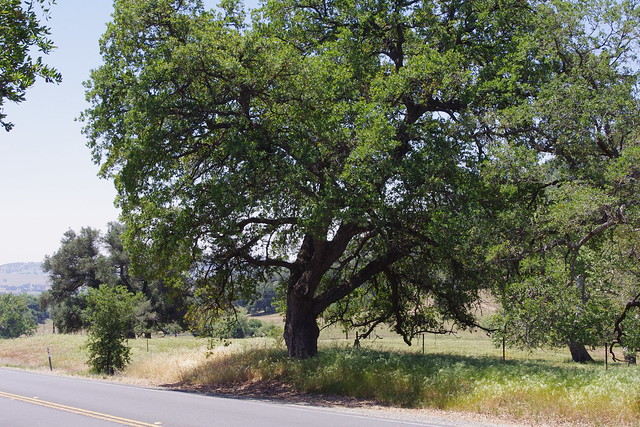 |
| Photo: Mine |
This oak tree was always beautiful and I considered it easy access for collecting acorns in the early 1980s. What a surprise to find most all of them germinating under the vicinity of this parent tree. That summer was extremely wet and the grasslands were all a rich green. The soils in the Fall were still damp from Summer Monsoons. Mind you, I say Fall, but actually it was late September. Notice to the left of the tree the smaller younger Engelmann Oak ??? This is one of those offspring. I know because I kept checking on all of the survival abily of those seedlings for a couple decades on and off. It wasn't so much that drought, predation etc was a factor as was the CalTrans spraying and mowing of roadside weeds. Below is a close up of that younger tree in 2013. To my knowledge, oaks like the Gambel Oak which are from the white oak group have little or no dormancy requirements and will germinate after maturing, while acorns of the black oak group exhibit embryo dormancy requirements and germinate the spring following fall sowing either by ScrubJays or Squirrels. Or people!
 |
| Photo: Mine |
Here is one of those young trees that made it. There were many others, but as checks and balances circumstances dictate, only a few can make it to maturity. Such a beautiful healthy tree and I highly doubt commuters and tourists ever give it a second look or even know of it's early on history of germination.
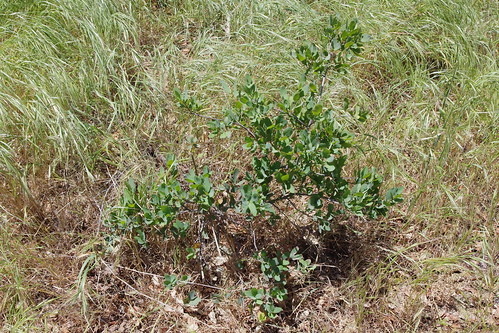 |
| Photo Mine |
This is another much younger oak located on the north side of the parent tree. Notice the chocking foxtail grasses and then the scene where I've pulled them away from the tree. Invasive non-native weeds are a hindrance to regeneration and no amount of control or prescribed burn is going to increase this trees numbers. Any burning would also destroy any seedling or saplings like the ones above or even Cal-Trans shoulder mowing operations. Now below here is an updated photo of the original seedling I saw back in the middle 1980s. What a difference from the 2013 photo. This was taken from Google Earth 2020. The foliage in this photo is a little sparse comared to the previous one, but partial summer dormancy is an important survival mechanism for Engelmann Oak.
 |
| Photo Update from Google Earth (2020) |
Now look at tthese photos from Pasadena streetscapes
 |
| Image from Barbara Eisenstein (May 13 2004) |
Weeding Wild Suburbia - Engelmann Oaks in Pasadena
 |
| Image - Barbara Eisenstein (October 12 2013) |
In conclusion on these Acorns I found at the Santa Ysabel roadside tree, take a close look at the collection of acorns on the right by by Barabara Eisenstain and notice the very largest acorns where some are still green ??? These are about the exact size I saw of acorns fallen underneath the Engelmann Oak across the Hwy 79 a few meters south of School House Canyon Road and the Santa Ysabel Tribal Headquarters. They were so big and heavy that wet monssonal season that all fell out of their caps and almost every single one was laying on the ground and sprouting in September in the early 1980s. Torrey Pines for me are another favourite to landscape with because they also are chaparral friendly, not overly dense allowing light to enter and reach low growing chaparral plants under them. This makes them perfect for urban landscapes for home owners, commercial landscapes and Municipal Park Projects. Unfortunately I have not seen enough of them in the cities, although I have seen them used in some places. Mostly the darker green Coast Live Oak gets favour because of it's dark greener foliage. Maybe the Engelmann Oak is overlooked because it has a bit of a bluegreen look which is not desired. Either way, landscapers are missing out and more field work by observing them in picturesque natural settings are what is needed for inspiration. At my mum's place when I first arrived I hit Las Pilitas Nursery north of Escondido CA along old Hwy 395 across from Champagne Lakes Campground and purchased a one gallon Engelmann Oak, planted it and have been excitedly watching it perform so well. In planting this and any other Cal Native plant (actually any plant period) DO NOT amend the soil ever. Simply loosen the soil around the sterile soil hole and heavily incorporate a blended multiple species mycorrhizal inoculum and water. Apply generous amounts of clean wood chip mulch on top of the soil and leave it alone. This should be the simple money saving rule with everything you plant. Once colonized with beneficial organisms, then NO FERTILIZERS should EVER be used. Do it and you'll lose everything. Water waaaaay too much and you'll also lose everything.
On a side note, most of the studies literature has suggested there is fossil evidence that Engelmann Oak was widespread during wetter time periods across the Mojave and Sonoran Deserts. I don't this for an instant since I am already fascinated with ancient wetter times anyway. Oaks like Maples which are given the title "Cloud Trees", are major cloud producing trees because of their great ability to produces large quantities of aerosols for water droplet nuclei formation in clouds and I have no doubt among other missing mechanisms that they played major roles in wetter summer monsoons. This is where I wonder about such a role during the days of ancient Lake Cahuilla. I have a future post on the vast oak woodlands of Anza Valley coming up soon. Humans have disrespected and butchered their environment for centuries. In times past the greed and selfishness while inexcusable was also coupled with ignorance on natural ecosystem functions. There is no such ignorance today, so the deliberate irresponsible behavior makes modern humans more accountable, I doubt fault anyone for being ignrant, but I do fault them for choosing to stay that way. In the mean time, the Southern california city of Pasadena is loaded with mature old growth Engelmann Oaks, sadly many now dying and not being replaced. Here is a photo and link to galley below from Weeding Wild Suburbia.
Two more photos of city streets from Pasadena with older Engelmann Oaks used or kept in the Landscape
 |
| Image by Barbara Eisenstein (2010) |
 |
| Image by Barbara Eisenstein (2003) |









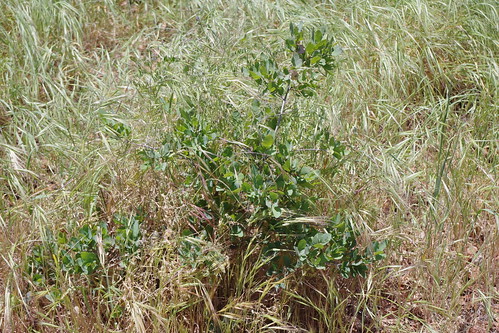




No comments:
Post a Comment
Thanks for visiting and stopping by with your comments!
I will try to respond to each comment within a few days, though sometimes I take longer if I'm too busy which appears to be increasing.